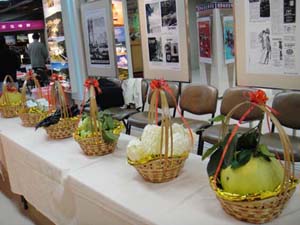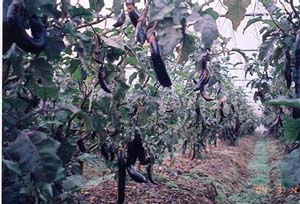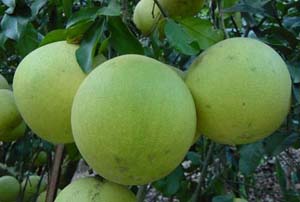
Your Site﹥﹥homepage﹥About Ershui﹥4. Regional features
|
|
|
|
|
|
|
|
|
|
|
4. Regional features |
||||||||||||||||||
|
1. Geographic location Ershui Township is located on the southern edge of the Bagua Tableland, the eastern side of the realm is next to a mountain, while the southern side has the northern shore of middle and downstream of Jhuoshuei River as the boundary. It is also at the apex of the Jhuoshuei River alluvial fan. The region is narrow and long, less than 30 sq. km. In the historical development, it was very closely connected to “mountain” and “water.” 2. Cultivation The grandfather generation took over the tasks of “opening the mountain” and “cultivating the river bottom,” as they continued to blaze the trail in wresting land from the mountain and rivers. Thus, the people of Ershui fully expressed the diligent and hardworking spirit in turning hillsides into orchards and riverbeds into rice farms; the people of Ershui Township are very proud of this. Ershui Township is at the apex of the north shore of Jhuoshuei River alluvial fan, and has long been an important passage between the plains and the “inner mountains.” Ancestors of the people of Ershui chose the land between Bagua Mt. and Jhuoshuei River as the place they wanted to settle. Even though the land is narrow and less than 30 sq. km, irrigation from Jhuoshuei River was able to create this great place with excellent water and mountain resources. In addition, at the beginning of 18th Century under the reign of Kangxi, the forefathers Shih-bang Shih and Shih-cing Huang constructed the canal at Ershui Bitsaitou, further improving agricultural development. 3. Difficulties Although two major canals constructed intersected Ershui Township, allowing the farmers easier access to irrigation, the two large canals and the Western Rail Line and Jiji Rail Line constructed after Japanese rule, and the County 137, 141, 152 highways constructed later totaled 7 water and land routes. These routes carved Ershui Township into small pieces of narrow land, so that agricultural cultivation became a major problem. This affected the livelihood of the people of Ershui, and Ershui Township became the poorest village of Changhua County; most people had to scrimp and save at the time. 4. Breakthrough However, then there was a turning point. In 1898 (under Japanese rule), there was a major flood that eroded and washed over much of Ershui Township. However, flooding of the Jhuoshuei River actually brought to the northern shore, close to the Ershui riverbed, a large piece of floating land; the soil churned by flooding on the sides of the river. Later, in order to protect the Changhua Plains, the Japanese government built dams on the northern shore to block rushing Dongluo River, so that it would be moved south to Xiluo Rover, forming more than 1000 ka of riverlands; the people of Ershui referred to it as “Sidiputsai.” 5. Development Early on, “Sidiputsai” was an uncultivated field with wild rabbits and other animals. Thus, it became a good place for the village people to hunt wild rabbits and birds. In addition, there were villagers who were more diligent who grew vetegables, yams, and peanuts along the bank, but at the time not many people wanted to cultivate “Sidiputsai.” After the Pacific War broke out, the agricultural products were requisitioned by Japan, resulting in a lack of resources for civilians. Food and other materials began to be rationed, with fixed amounts given for the population. At the same time, the Japanese government encouraged the people to plant vegetables and grains on idle land to make up for insufficiencies of resources. In order to take care of their families, the people of Ershui regained the cultivation spirit of their ancestors, as they went up and down the mountains and rivers, farmed the mountainsides, planting fruit and grains to support their families. There were also people who opened canals on the river lands to guide the water of Jhuoshuei River for irrigation to plan rice paddies. The output was surprisingly high, and the quality was not any lower than the rice paddies within the dams. The Japanese government did not believe that river land farms were within the scope for taxation, many people were encouraged to pick up their hoes to farm the “bottom of the river.” As long as it was arable, nearly all the riverbeds of small and large rivers were cultivated by farmers. Now, looking over the riverbeds, other than those with water flow or cannot be cultivated, nearly all land has become farmland. The farmers fought for the land with the water, turning “barren land into fertile fields, riverbeds into farms.” This sort of hardworking spirit is worthy of admiration! 6. Accomplishments Now, Ershui Township’s “river-bottom farms” have been irrigated and improved by sand from the Jhuoshuei River, becoming excellent fields and farms, contributing greatly to the agricultural economy of Ershui Township. The river-bottom farms of Ershui Township produce eggplant, white bitter melon, black soil red sugarcane, as well as the white shaddock and guava grown on the slopes, which are all famous and popular among consumers. Standing on the Ershui dam and overlooking the vast and prosperous “river bottom farms,” one cannot help but feel gratitude and respect for the spirit of ancestors who sweat and bled to wrest land from the rivers.
7. Section conclusion Ershui Township is situated close to mountains and rivers. This small village in a corner of Changhua County has villagers who with limited land resources, could rely on food from the mountain and wrest land from the river, creating orchards and farms that covered the mountain slopes. With the cultivation and planting by ancestors, the generations that come after should of course cherish all the resources that were difficult to come by. They should co-exist and co-prosper with the mountains and rivers to maintain its excellent results and praise of “good mountain, good water, good Ershui!” |
||||||||||||||||||
Source of photo: Ershui Township Hall, Bitsetou Recreational Farm Xuite blog, Yuanchuan Elementary School website



